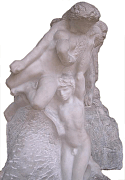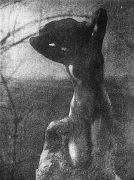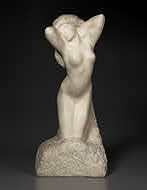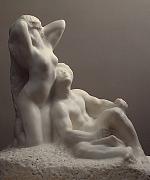|
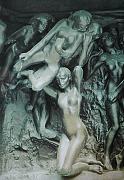 We find the 'Kneeling Fauness'
in the left half of the tympanum of 'The
Gates of Hell', underneath other female figures - the most prominent
of them later known as 'The
Martyr'. We find the 'Kneeling Fauness'
in the left half of the tympanum of 'The
Gates of Hell', underneath other female figures - the most prominent
of them later known as 'The
Martyr'.
 The superimposition of these women had evolved from the sculptor's concept
to
populate his monumental portal
with a great number of characters, closely flocked together in the chaotic
turmoil of the Inferno; in later years, Rodin
preserved this accidental combination under the title 'Orpheus and the
Furies' - changing the gender of the kneeling figure by decorating it with
a miniature penis and amputating the breasts. Around 1889, the somewhat
awkward assemblage was eternalized in
marble; one example is exhibited at the Musée Rodin.
The superimposition of these women had evolved from the sculptor's concept
to
populate his monumental portal
with a great number of characters, closely flocked together in the chaotic
turmoil of the Inferno; in later years, Rodin
preserved this accidental combination under the title 'Orpheus and the
Furies' - changing the gender of the kneeling figure by decorating it with
a miniature penis and amputating the breasts. Around 1889, the somewhat
awkward assemblage was eternalized in
marble; one example is exhibited at the Musée Rodin.
Grappe dated the origin of 'The Kneeling Fauness' back
to 1882-83; a plaster called 'Condemned Fauness' owned by a collector
named Stenesco was dated 1884, but Grappe, referring to the modeling,
places it among the very first projects for 'The Gates'.
Already during his years in the porcelain manufactury in Sèvres,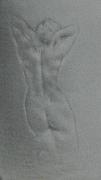 Rodin had decorated his 'Vase de Saigon' with a kneeling woman, her elbows
raised, hands meeting behind her head.
Rodin had decorated his 'Vase de Saigon' with a kneeling woman, her elbows
raised, hands meeting behind her head.
Although the body of the 'Fauness' is pleasing, the
young woman lifting her buttocks like in 'The
Spinx', the face is rudely modeled, the mouth distorted, the head
pressed forward, rendering an expression of guilt and tense anxiety -
quite appropriate for the setting among the other 'damned women' presented
in the tympanum. Apart from this animalistic trait, we find no attributes
that would identify the character as a fauness or satyress.
In 1889, a 'Kneeling Fauness' was exhibited at the
Rodin-Monet exhibition. In a second version, the head of 'The Fauness' is
leaning back and facing to the right - this is the figure Rodin used to
illustrate the poem 'le Guignon' by Charles Baudelaire in 'Les Fleurs du
Mal', between 1886-88.
|
Le guignon
Pour soulever un poids si lourd,
Sisyphe, il faudrait ton courage !
Bien qu'on ait du coeur à l'ouvrage,
L'Art est long et le Temps est court.
Loin des sépultures célèbres,
Vers un cimetière isolé,
Mon coeur, comme un tambour voilé,
Va battant des marches funèbres.
- Maint joyau dort enseveli
Dans les ténèbres et l'oubli,
Bien loin des pioches et des sondes ;
Mainte fleur épanche à regret
Son parfum doux comme un secret
Dans les solitudes profondes.
Charles Baudelaire
'Les Fleurs du Mal' |
Evil Fate
To lift a weight so heavy,
Would take your courage, Sisyphus!
Although one's heart is in the work,
Art is long and Time is short.
Far from famous sepulchers
Toward a lonely cemetery
My heart, like muffled drums,
Goes beating funeral marches.
Many a jewel lies buried
In darkness and oblivion,
Far, far away from picks and drills;
Many a flower regretfully
Exhales perfume soft as secrets
In a profound solitude.
Translation: William Aggeler, The Flowers of Evil
(Fresno, CA: Academy Library Guild, 1954) |
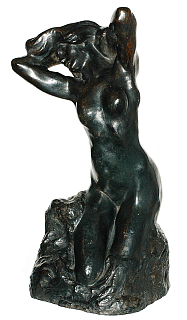 In
this posture, the work became known as 'Toilette of Venus', or 'Awakening',
as seen on the photographs by Haweis and Coles. In
this posture, the work became known as 'Toilette of Venus', or 'Awakening',
as seen on the photographs by Haweis and Coles.
The face was harmonized, the hair-do elongated by an undulating extension,
adding to the overall elegance and attractivity of the character.
The subject of the Goddess of Love and Beauty, arranging her hair or
glancing into a mirror, often accompanied by her little son Amor, had been a popular subject throughout Renaissance and
Baroque painting; the very same title had been used for the works by François
Boucher (oil on canvas, 1751, Metropolitan Museum of Art, New York)
and by Giovanni Francesco Barbieri "Il Guercino" in 1621, for example.
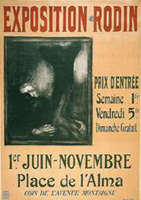 Rodin's 'Venus' became so popular, that his friend and
colleague Eugene Carrière (1849-1906) selected it as the motif for the poster announcing Rodin's private
retrospective in the pavillon at the Place d'Alma in 1900. Rodin's 'Venus' became so popular, that his friend and
colleague Eugene Carrière (1849-1906) selected it as the motif for the poster announcing Rodin's private
retrospective in the pavillon at the Place d'Alma in 1900.
 The model for both the 'Kneeling Fauness' and 'Toilette
of Venus' may have been the dark-haired Italian Carmen Visconti of
Fiesole, who had modeled for Rodin during a period of 13 years, including
the early 1880's. In several press interviews, Carmen Visconti had
recollected her model sessions for 'Eve', 'The Kiss' and 'The Wave'; according
to Lynne Ambrosini,
the latter denomination was another title for 'Toilette of Venus'.
Although I found no direct confirmation for this equation, the plaster
assemblage 'The Crest and the Wave' also shows a figure streching her arms
upward; moreover, a marble version of 'The Sirens' (1888)- on the left
side featuring a kneeling woman very similar to 'The
Sphinx' (1886) and 'Venus' - in Montreal is also known as 'The Wave'. The model for both the 'Kneeling Fauness' and 'Toilette
of Venus' may have been the dark-haired Italian Carmen Visconti of
Fiesole, who had modeled for Rodin during a period of 13 years, including
the early 1880's. In several press interviews, Carmen Visconti had
recollected her model sessions for 'Eve', 'The Kiss' and 'The Wave'; according
to Lynne Ambrosini,
the latter denomination was another title for 'Toilette of Venus'.
Although I found no direct confirmation for this equation, the plaster
assemblage 'The Crest and the Wave' also shows a figure streching her arms
upward; moreover, a marble version of 'The Sirens' (1888)- on the left
side featuring a kneeling woman very similar to 'The
Sphinx' (1886) and 'Venus' - in Montreal is also known as 'The Wave'.
|


 Rodin had decorated his '
Rodin had decorated his ' In
this posture, the work became known as 'Toilette of Venus', or 'Awakening',
as seen on the photographs by Haweis and Coles.
In
this posture, the work became known as 'Toilette of Venus', or 'Awakening',
as seen on the photographs by Haweis and Coles.
 Rodin's 'Venus' became so popular, that his friend and
colleague Eugene Carrière (1849-1906) selected it as the motif for the poster announcing Rodin's private
retrospective in the pavillon at the Place d'Alma in 1900.
Rodin's 'Venus' became so popular, that his friend and
colleague Eugene Carrière (1849-1906) selected it as the motif for the poster announcing Rodin's private
retrospective in the pavillon at the Place d'Alma in 1900.
 The model for both the 'Kneeling Fauness' and 'Toilette
of Venus' may have been the dark-haired Italian Carmen Visconti of
Fiesole, who had modeled for Rodin during a period of 13 years, including
the early 1880's. In several press interviews, Carmen Visconti had
recollected her model sessions for 'Eve', 'The Kiss' and 'The Wave'; according
to Lynne Ambrosini,
the latter denomination was another title for 'Toilette of Venus'.
Although I found no direct confirmation for this equation, the plaster
assemblage 'The Crest and the Wave' also shows a figure streching her arms
upward; moreover, a marble version of 'The Sirens' (1888)- on the left
side featuring a kneeling woman very similar to
The model for both the 'Kneeling Fauness' and 'Toilette
of Venus' may have been the dark-haired Italian Carmen Visconti of
Fiesole, who had modeled for Rodin during a period of 13 years, including
the early 1880's. In several press interviews, Carmen Visconti had
recollected her model sessions for 'Eve', 'The Kiss' and 'The Wave'; according
to Lynne Ambrosini,
the latter denomination was another title for 'Toilette of Venus'.
Although I found no direct confirmation for this equation, the plaster
assemblage 'The Crest and the Wave' also shows a figure streching her arms
upward; moreover, a marble version of 'The Sirens' (1888)- on the left
side featuring a kneeling woman very similar to 